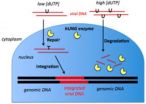(Press-News.org) This press release is available in German.
Image sensors are at the core of every digital camera. Before a snapshot appears on the display, the sensors first convert the light from the lens to electrical signals. The image processor then uses these to create the final photo.
Many compact and cellphone cameras contain silicon-based image sensors produced using CMOS (complementary metal oxide semiconductor) technology. Prof. Paolo Lugli and Dr. Daniela Baierl from TUM have developed a cost-effective process to improve the performance of these CMOS sensors. Their approach revolves around an ultra-thin film made of organic compounds, in other words plastics.
The challenge lay in applying the plastic solution to the surface of the image sensors. The researchers tested spin- and spray-coating methods to apply the plastic in its liquid, solution form as precisely and cost-effectively as possible. They were looking for a smooth plastic film that is no more than a few hundred nanometers thick. Spray-coating was found to be the best method, using either a simple spray gun or a spray robot.
Thin coating with high sensitivity to light
Organic sensors have already proven their worth in tests: They are up to three times more sensitive to light than conventional CMOS sensors, whose electronic components conceal some of the pixels, and therefore the photoactive silicon surface.
Organic sensors can be manufactured without the expensive post-processing step typically required for CMOS sensors, which involves for example applying micro-lenses to increase the amount of captured light. Every part of every single pixel, including the electronics, is sprayed with the liquid polymer solution, giving a surface that is 100 percent light-sensitive. The low noise and high frame rate properties of the organic sensors also make them a good fit for cameras.
Potential for developing low-cost infrared sensors
Another advantage of the plastic sensors is that different chemical compounds can be used to capture different parts of the light spectrum. For example, the PCBM and P3HT polymers are ideal for the detection of visible light. Other organic compounds, like squaraine dyes, are sensitive to light in the near-infrared region.
"By choosing the right organic compounds, we are able to develop new applications that were too costly up until now," explains Prof. Paolo Lugli, who holds the Chair of Nanoelectronics at TUM. "The future uses of organic infrared sensors include driver assistance systems for night vision and regular compact and cellphone cameras. Yet, the lack of suitable polymers is the main hurdle."
INFORMATION:
Publication:
Daniela Baierl, Lucio Pancheri, Morten Schmidt, David Stoppa, Gian-Franco Dalla Betta, Giuseppe Scarpa, Paolo Lugli, 2012: A hybrid CMOS-imager with a solution-processable polymer as photoactive layer, Nature Communications, doi:10.1038/ncomms2180
http://www.nature.com/ncomms/journal/v3/n10/full/ncomms2180.html
Contact:
Technische Universität München
Institute for Nanoelectronics
Prof. Paolo Lugli
T: +49 (0) 89 289 25333
E: lugli@tum.de
W: www.nano.ei.tum.de
Image sensors out of a spray can
Organic sensors increase light sensitivity of cameras
2013-01-22
ELSE PRESS RELEASES FROM THIS DATE:
Public acceptance of climate change affected by word usage
2013-01-22
Public acceptance of climate change's reality may have been influenced by the rate at which words moved from scientific journals into the mainstream, according to anthropologist Michael O'Brien, dean of the College of Arts and Science at the University of Missouri. A recent study of word usage in popular literature by O'Brien and his colleagues documented how the usage of certain words related to climate change has risen and fallen over the past two centuries. Understanding how word usage affects public acceptance of science could lead to better science communication and ...
LSUHSC research provides new drug target for Her-2 related breast cancer
2013-01-22
New Orleans, LA – Research led by Dr. Suresh Alahari, the Fred Brazda Professor of Biochemistry and Molecular Biology at LSU Health Sciences Center New Orleans and its Stanley S. Scott Cancer Center, details exactly how the Her2 cancer gene promotes the progression and spread of breast cancer cells. The inactivation of a tumor suppression gene called Nischarin is among the mechanisms identified. The findings provide a new therapeutic target to block the function of Her2. The research was published in Cancer Research, OnlineFirst on January 21, 2013.
About 30% of breast ...
Bioethics leader calls for bold approach to fighting obesity
2013-01-22
(Garrison, NY) Arguing that obesity "may be the most difficult and elusive public health problem the United States has ever encountered" and that anti-obesity efforts having made little discernible difference, Daniel Callahan, co-founder and President Emeritus of The Hastings Center, proposes a bold and controversial approach to fighting the epidemic.
Callahan says that the public health community can learn from one of the most successful public health campaigns: the anti-smoking campaign. A primary strategy has been to stigmatize smokers, he says, making it clear that ...
From dark hearts comes the kindness of mankind
2013-01-22
The kindness of mankind most likely developed from our more sinister and self-serving tendencies, according to Princeton University and University of Arizona research that suggests society's rules against selfishness are rooted in the very exploitation they condemn.
The report in the journal Evolution proposes that altruism — society's protection of resources and the collective good by punishing "cheaters" — did not develop as a reaction to avarice. Instead, communal disavowal of greed originated when competing selfish individuals sought to control and cancel out one ...
SEC-mandated XBRL data at risk of being irrelevant to investors and analysts
2013-01-22
NEW YORK - January 22, 2013 - In 2009, the Securities and Exchange Commission mandated that public companies submit portions of annual (10-K) and quarterly (10-Q) reports—in a digitized format known as eXtensible Business Reporting Language (XBRL). The goal of this type of data was to provide more relevant, timely, and reliable "interactive" data to investors and analysts. The XBRL-formatted data is meant to allow users to manipulate and organize the financial information according to their own purposes faster, cheaper, and more easily than current alternatives.
But how ...
Brain structure of infants predicts language skills at 1 year
2013-01-22
Using a brain-imaging technique that examines the entire infant brain, researchers have found that the anatomy of certain brain areas – the hippocampus and cerebellum – can predict children's language abilities at 1 year of age.
The University of Washington study is the first to associate these brain structures with future language skills. The results are published in the January issue of the journal Brain and Language.
"The brain of the baby holds an infinite number of secrets just waiting to be uncovered, and these discoveries will show us why infants learn languages ...
Annals of Internal Medicine Tip Sheet for Jan. 22, 2013
2013-01-22
1. Evidence Review: Some Behavioral Interventions May Reduce Child Abuse and Neglect
Risk assessment and behavioral interventions in pediatric clinics may reduce child abuse and neglect, according to a recent evidence review. Researchers reviewed studies published since 2004 when the U.S. Preventive Services Task Force last published recommendations on child abuse and neglect to determine the effectiveness of primary care relevant interventions on child abuse and neglect outcomes. The researchers also sought to determine adverse effects of interventions. Physicians and ...
Researchers show how cells' DNA repair machinery can destroy viruses
2013-01-22
A team of researchers based at Johns Hopkins has decoded a system that makes certain types of immune cells impervious to HIV infection. The system's two vital components are high levels of a molecule that becomes embedded in viral DNA like a code written in invisible ink, and an enzyme that, when it reads the code, switches from repairing the DNA to chopping it up into unusable pieces. The researchers, who report the find in the Jan. 21 early edition of the Proceedings of the National Academy of Sciences, say the discovery points toward a new approach to eradicating HIV ...
New way to kill lymphoma without chemotherapy
2013-01-22
CHICAGO --- How do you annihilate lymphoma without using any drugs?
Starve it to death by depriving it of what appears to be a favorite food: HDL cholesterol.
Northwestern Medicine® researchers discovered this with a new nanoparticle that acts like a secret double agent. It appears to the cancerous lymphoma cell like a preferred meal -- natural HDL. But when the particle engages the cell, it actually plugs it up and blocks cholesterol from entering. Deprived of an essential nutrient, the cell eventually dies.
A new study by C. Shad Thaxton, M.D., and Leo I. Gordon, ...
Hearing loss accelerates brain function decline in older adults
2013-01-22
Older adults with hearing loss are more likely to develop problems thinking and remembering than older adults whose hearing is normal, according to a new study by hearing experts at Johns Hopkins.
In the study, volunteers with hearing loss, undergoing repeated cognition tests over six years, had cognitive abilities that declined some 30 percent to 40 percent faster than in those whose hearing was normal. Levels of declining brain function were directly related to the amount of hearing loss, the researchers say. On average, older adults with hearing loss developed a significant ...
LAST 30 PRESS RELEASES:
UVA’s Jundong Li wins ICDM’S 2025 Tao Li Award for data mining, machine learning
UVA’s low-power, high-performance computer power player Mircea Stan earns National Academy of Inventors fellowship
Not playing by the rules: USU researcher explores filamentous algae dynamics in rivers
Do our body clocks influence our risk of dementia?
Anthropologists offer new evidence of bipedalism in long-debated fossil discovery
Safer receipt paper from wood
Dosage-sensitive genes suggest no whole-genome duplications in ancestral angiosperm
First ancient human herpesvirus genomes document their deep history with humans
Why Some Bacteria Survive Antibiotics and How to Stop Them - New study reveals that bacteria can survive antibiotic treatment through two fundamentally different “shutdown modes”
UCLA study links scar healing to dangerous placenta condition
CHANGE-seq-BE finds off-target changes in the genome from base editors
The Journal of Nuclear Medicine Ahead-of-Print Tip Sheet: January 2, 2026
Delayed or absent first dose of measles, mumps, and rubella vaccination
Trends in US preterm birth rates by household income and race and ethnicity
Study identifies potential biomarker linked to progression and brain inflammation in multiple sclerosis
Many mothers in Norway do not show up for postnatal check-ups
Researchers want to find out why quick clay is so unstable
Superradiant spins show teamwork at the quantum scale
Cleveland Clinic Research links tumor bacteria to immunotherapy resistance in head and neck cancer
First Editorial of 2026: Resisting AI slop
Joint ground- and space-based observations reveal Saturn-mass rogue planet
Inheritable genetic variant offers protection against blood cancer risk and progression
Pigs settled Pacific islands alongside early human voyagers
A Coral reef’s daily pulse reshapes microbes in surrounding waters
EAST Tokamak experiments exceed plasma density limit, offering new approach to fusion ignition
Groundbreaking discovery reveals Africa’s oldest cremation pyre and complex ritual practices
First breathing ‘lung-on-chip’ developed using genetically identical cells
How people moved pigs across the Pacific
Interaction of climate change and human activity and its impact on plant diversity in Qinghai-Tibet plateau
From addressing uncertainty to national strategy: an interpretation of Professor Lim Siong Guan’s views
[Press-News.org] Image sensors out of a spray canOrganic sensors increase light sensitivity of cameras

